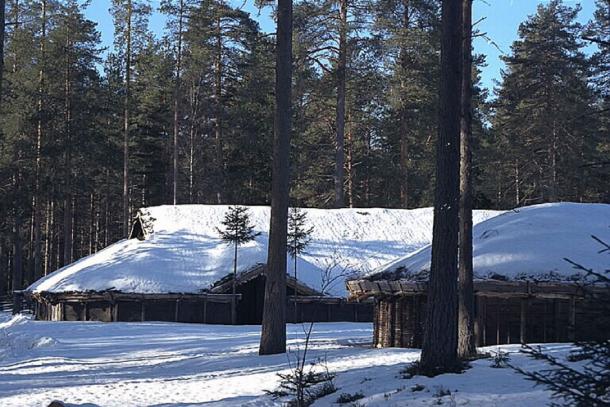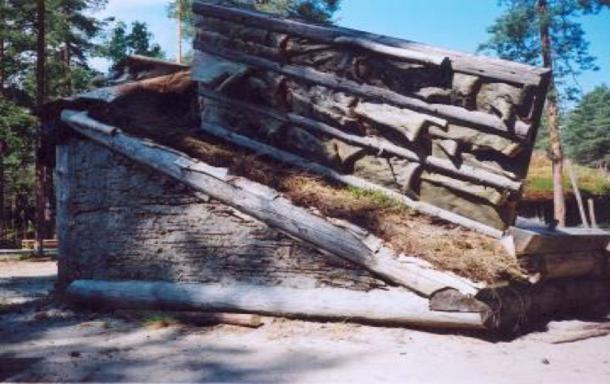
Gene Fornby: The Ancient Swedish Village That Predates the Vikings
Located just outside Örnsköldsvik in northern Sweden, Gene Fornby is a reconstructed archaeological open-air museum based on the finds of an ancient settlement. It became a popular tourist attraction when it opened to the public in 1991 and demonstrates how the village would have appeared during the period of occupation more than 1500 years ago.
The family that lived there lived well, and they had been doing so for generations. Food was plentiful as they farmed the land, and the sea gave them fish and seals. During occupation the water would have reached the edge of the village, although currently the site sits 65 feet (20 meters) above sea level due to environmental changes in the area. The family lived there when iron, bronze and pearls were considered precious goods. They traded with nearby settlements and provided items they made in the smithy. The surrounding forests provided them with timber from which they built their homes, their boats, and made crafts.
- Was It Just a Boss Spying on His Workers? First Viking Age Tower Found in Denmark
- Submerged Stone Age Settlement ‘Opens Up New Path’ for Finnish Archaeology
- Pre-Viking Iron Age settlement will give a glimpse of life in Norway 1,500 years ago

Reconstructed long house at Gene Fornby under snow. (CC BY 2.5)
Gene Fornby is operated by the Örnsköldsvik Museum & Art Gallery and is open during summer with interpreters and historians dressed in period costume. While education and entertainment are deemed important, both the university and the local museum are still involved in ongoing research.
The area was excavated primarily from 1977 to 1988 by archaeologists from the University of Umeå who found traces of human activity in the area dating back to the Nordic Bronze Age (1700–500 BC), but the settlement itself dates back to the Roman Iron Age and the Migration Period, from around the years 400-600 AD.
The Smithy Was Large Enough To Contain Four Forges
The forge is believed to have been one of the largest in prehistoric Scandinavia. Traces of iron production and processing were uncovered as well as bronze casting refuse, and even a textile workshop. The bronze casting molds for embossed buckles are an unusual type that have only been found at about ten locations throughout the Nordic region, and Genes Fornby is the only known manufacturing site. The archaeological evidence show that an iron industry had been an important part of the settlement.

Iron objects made in the forge (Örnsköldsvik Municipality)
A cemetery with nine low burial mounds was found in the main excavation area, while four more burial mounds were found not far away. The thirteen burial mounds, thought to be chieftain graves from the years 100 to 600 AD, are of great significance. Contrary to the previous archaeological assumption that there was probably no resident population in the northern parts of Sweden before the Viking Age (792 to 1066 AD), the graves prove Gene Fornby was one of the earliest settlements in this part of Sweden.
- Blå Jungfrun Island, Sweden: Where Witches Dwell and Labyrinths Confuse
- Metals in Bronze Age Weapons Discovered in Sweden Came from Distant Lands
- Over 80 Strange Bronze Age Holes Discovered in Sweden. Why Did People Gather there 3000 Years Ago?
Among the artifacts found at the site are knives, arrowheads, bone combs, pottery, clothing buckles and buttons, as well as beads of bronze, glass, bone and clay. Waste from handicraft production indicates that a great number of objects were made on site.
Gene Fornby spans over two periods - during the first phase there was a longhouse, a barn which held corn, as well as a workshop. Then the second phase started when they demolished the old buildings and built a new longhouse, a barn and also the large smithy.
In total, fourteen houses were found in the excavation area. Thirteen of the buildings belong to the Iron Age settlement, and one house dates to the 1200s.

A ‘grophus’ or house at Gene Fornby (CC BY SA-3.0)
Found just northwest of the settlement were, among other things, several charred logs, nail like objects, flint flakes and an iron key. Samples of the charred wood have been dated to the Migration Period, which is consistent with the dating of the key.
The Fight For Preservation Lasted Over Ten Years
The site, however, was not without controversy. For many years, the politicians of the City Council of Örnsköldsvik argued over the ‘use’ of Gene Fornby and the site was at risk even though it was marked by The Swedish National Heritage Board as an archaeological location. After several years of struggle, those who fought for the preservation of the site generated more and more followers and were eventually victorious in 2012. The site was transferred to the Örnsköldsvik Municipality for preservation in 2013.
Top image: Reconstructed longhouse at Gene Fornby Source: CC BY-SA 3.0
References
Thunberg, C.L. 2013. Gene Fornby - the Ancient Village of Gene. Archaeologial Open-Air Museum
Available at: http://exarc.net/issue-2013-1/aoam/gene-fornby-ancient-village-gene
Gene Fornby Site. Available at: http://www.dufvabygg.se/gene/om.html
2018. Örnsköldsvik, Gene Fornby. Historia Vivens
Available at: http://www.historiavivens.eu/2/oernskoeldsvik_gene_fornby_574076.html
















Comments
The Viking did NOT bury their dead. Like the ancient Greeks, funeral pyres were the method of sending the dearly departed up to the heavens. The latin root word of ‘funeral’ is torch. So, any bodies found buried were likely victims of structural collapse or some deadly atmospheric conditions (possibly related to the sudden cause the Ice Age) and then buried via glaciation and sediment accumulation of tens of thousands of years. They have many convenient ways to deny the bone carbon-dating. Sometimes they just date the layers of sediment over the bones.
Nobody gets paid to tell the truth.
You stated that corn was found in a barn from the first phase of development. Was the corn tested to determine its age? Corn wasn’t introduced into the old world till the late 15th and early 16th century.